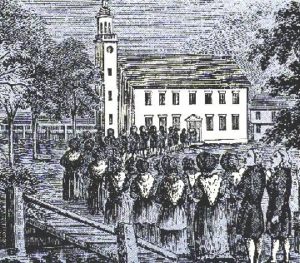Jun
23
Headcoverings and Christian Country Clubs
MORES (pronounced like “morays”): “folkways of central importance accepted without question and embodying the fundamental moral views of a group” — Webster’s Dictionary
Bible reading can be… confusing, at times. And, even when it doesn’t seem to be, sometimes we misunderstand what is actually being advised, commanded, described, or otherwise referred to. One of the reasons this happens is an unfamiliarity with the cultural milieu within which the biblical events took place. As a result, we may subconsciously bring our own modern, Western worldview and cultural mores into our Bible reading, which results in a lesson foreign to what the original audience would have understood.
 In other words, in order to better understand what the biblical authors — and, through them, God — are communicating, we need to try to be more aware of when we might be making these (Western) assumptions. It helps to read some background information about the biblical people groups, worldviews, and customs in that historical setting.
In other words, in order to better understand what the biblical authors — and, through them, God — are communicating, we need to try to be more aware of when we might be making these (Western) assumptions. It helps to read some background information about the biblical people groups, worldviews, and customs in that historical setting.
In Misreading Scripture with Western Eyes, authors E. Randolph “Randy” Richards and Brandon J. O’Brien discuss nine differences between Western and non-Western cultures that we should be aware of when we read and interpret the Bible. In the first chapter, Richards and O’Brien talk about the often-competing systems of values and codes of conduct that Christians get “squeezed between”.
“It is difficult to live in this tension. So we feel happiest when we can satisfy two conflicting mores with some sort of compromise [Note: Not in the negative sense.], as our Christian fathers did with theater. This applies, of course, to other mores, including the three we will discuss below: sex, food and money.”
Below is an excerpt I thought you might enjoy…
—
“What goes without being said about money in Western culture can lead us to be blind to lessons about money that we may think are about something else. Paul tells women in Corinth that they must have their head covered when they worship (1 Cor 11:5-6). It is not immediately clear to us what the problem is, so we may assume something went without being said, which is a good instinct. So perhaps we assume that a woman’s hair was somehow sexually alluring to ancient people and that therefore a Christian woman needed to cover hers. We may then reason that since hair today is not a sexual turn-on, it is okay for a Christian woman to wear her hair down.
 We are correct that something went without being said, but we are wrong about what that was. Paul is indeed talking about modesty. In our culture, if male ministers are talking about what a Christian woman should be wearing, we are almost always discussing sexual modesty or the lack thereof, so we typically assume that’s what Paul is doing here. We feel affirmed when Paul mentions that it is disgraceful if a woman doesn’t cover her head (1 Cor 11:6).
We are correct that something went without being said, but we are wrong about what that was. Paul is indeed talking about modesty. In our culture, if male ministers are talking about what a Christian woman should be wearing, we are almost always discussing sexual modesty or the lack thereof, so we typically assume that’s what Paul is doing here. We feel affirmed when Paul mentions that it is disgraceful if a woman doesn’t cover her head (1 Cor 11:6).
Likely, however, Paul was admonishing the hostess of a house church to wear her marriage veil (‘cover her head’) because ‘church’ was a public event and because respectable Roman women covered their heads in public. These Corinthian women were treating church like their private dinner parties. These dinners (convivia, or ‘wine parties’) were known for other immoral activities including dinner ‘escorts’ (1 Cor 6), idol meat (1 Cor 8-10), adultery (1 Cor 10) and drunkenness (1 Cor 11). The issue was modesty, but not sexual modesty. These women were co-opting an activity about God for personal benefit. They were treating church as a social club.
Paul discusses women’s apparel again in 1 Timothy. Again, the issue is modesty (1 Tim 2:9). In Timothy’s church in Ephesus, some women were dressing inappropriately. Again we might assume Paul is concerned about sexual modesty. Contextually, however, a case can be made that Paul meant, ‘Women should dress economically modestly’ so as not to flaunt their wealth. The remainder of 1 Timothy 2:9 reads, ‘with decency and propriety… not with elaborate hairstyles or gold or pearls or expensive clothes.’ Paul mentions a triad of trouble (anger, quarreling/disputes and economics) for women here in 1 Timothy 2:8-9. But this is not solely a feminine problem. He applies the same triad in the following passage addressed to the men: ‘not violent but gentle, not quarrelsome, not a lover of money’ (1 Tim 3:3). Our cultural mores tell us sexual modesty is necessary while economic modesty is considerate: preferable but not necessary.
In other words, one of the ways Westerners routinely misread instructions about modesty in the Bible is by assuming sexual modesty is of greater concern than economic modesty. Where two mores — sex and money — collide, we see which is more important to us. And when we project our own cultural mores onto the original audience of the Bible, we may fail to apply the Bible correctly in our own lives. It is certainly important for men and women alike to arrive for worship in attire that is sexually modest. But we seem to have no trouble turning sacred spaces into Christian country clubs. We see no dangers in the human tendency to assert our status in the way we dress.
That most modest of Christian communities, the American Puritans, were certainly not inclined to wear revealing clothing. But certain worship customs in colonial New England threatened economic modesty in Christian gatherings. In New England churches, families paid their tithes by renting pews. The wealthier the family, the better seats they could afford. So the social structure outside the church was reinforced in miniature on Sunday mornings: the wealthiest and most important Christians sat in the center pews nearest the pulpit; the poorer folks sat on the margins. In some cases, the wealthy were seated first, while the others watched and waited. There could be no mistake regarding who were the most important and influential church members.
Nearly three hundred years later, American Christians might shake their heads at this obviously un-Christian behavior. But the tendency remains. Today we are not judged by the order in which we enter church, but we may judge others by what they drive into the parking lot. Many of us wear our ‘Sunday best’ to church because we claim we want to look our best for God. But God sees us all week. Is it really God for whom we want to look our best?
In other words, if we understand Paul’s exhortation that women should dress modestly to mean only that their clothes should not be sexually revealing, we may think his words hold no challenge for us today. If we recognize that his concern might instead be economic, then the exhortation is timely for most Western churches, in which everyone keeps their shirts on but in which some dress in ways that say: ‘We have more money than you.'”
—
I seem to remember once learning that the admonition for modesty in 1 Timothy 2 was so that the women wouldn’t look like the gaudily-dressed prostitutes (or some such thing). Contextually, though, the idea of economic modesty may indeed be a better interpretation. I don’t know about you, but this (and other things I’m reading in Richards and O’Brien’s book) has encouraged me to be more cautious in my cultural assumptions when reading Scripture. I also hope to become better informed about the people and customs of biblical times. You?

















